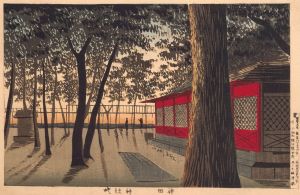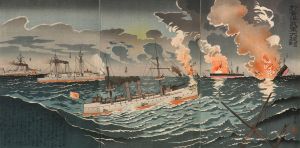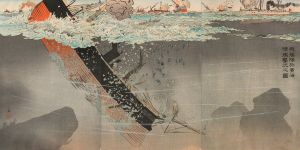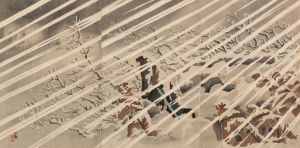
Our Fleet of Warships Bombarding Dalian Bay
A hand-painted replica of Kobayashi Kiyochika’s masterpiece Our Fleet of Warships Bombarding Dalian Bay, meticulously crafted by professional artists to capture the true essence of the original. Each piece is created with museum-quality canvas and rare mineral pigments, carefully painted by experienced artists with delicate brushstrokes and rich, layered colors to perfectly recreate the texture of the original artwork. Unlike machine-printed reproductions, this hand-painted version brings the painting to life, infused with the artist’s emotions and skill in every stroke. Whether for personal collection or home decoration, it instantly elevates the artistic atmosphere of any space.
Kobayashi Kiyochika was a prominent Japanese ukiyo-e artist known for his innovative approach to woodblock prints, particularly during the Meiji era. One of his notable works is "Our Fleet of Warships Bombarding Dalian Bay," which captures a significant moment during the First Sino-Japanese War (1894-1895). This conflict marked Japan's emergence as a modern military power and was pivotal in establishing its influence over Korea and parts of China.
"Our Fleet of Warships Bombarding Dalian Bay" is part of a series of prints by Kiyochika that documented the events of the war. These prints were not only artistic expressions but also served as a form of wartime propaganda, intended to bolster national pride and support for Japan's military endeavors. Kiyochika's work is characterized by its dramatic use of light and shadow, a technique he mastered through his study of Western art and photography. This particular print showcases his ability to blend traditional Japanese woodblock techniques with Western influences, creating a dynamic and engaging portrayal of naval warfare.
The scene depicted in the print is set in Dalian Bay, located in the Liaodong Peninsula of China. During the First Sino-Japanese War, Dalian Bay was a strategic location due to its proximity to the Chinese naval base at Port Arthur (now Lüshunkou). The Japanese navy's bombardment of this area was part of a larger campaign to secure control over the Yellow Sea and to cut off Chinese supply lines. Kiyochika's print captures the intensity of the naval engagement, with Japanese warships firing upon Chinese positions, smoke billowing from the cannons, and the tumultuous sea reflecting the chaos of battle.
Kiyochika's work is notable for its attention to detail and its ability to convey the power and modernity of the Japanese fleet. The ships are depicted with precision, highlighting Japan's advancements in naval technology and its adoption of Western-style warships. This modernization was a key factor in Japan's success during the war, as it allowed the Japanese navy to outmaneuver and outgun the Chinese forces.
In addition to its historical significance, "Our Fleet of Warships Bombarding Dalian Bay" is an example of Kiyochika's broader contribution to the art world. His prints from the First Sino-Japanese War period are considered some of his most important works, as they reflect both the changing nature of Japanese society and the country's growing ambitions on the world stage. Through his art, Kiyochika not only documented a critical moment in Japanese history but also helped to shape the narrative of Japan's rise as a modern nation.
Overall, Kobayashi Kiyochika's "Our Fleet of Warships Bombarding Dalian Bay" is a significant work that combines artistic innovation with historical documentation, offering insight into both the First Sino-Japanese War and the broader cultural shifts occurring in Japan during the late 19th century.















